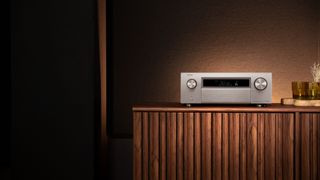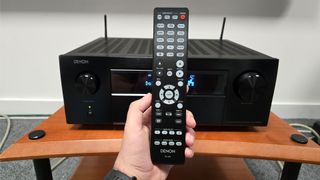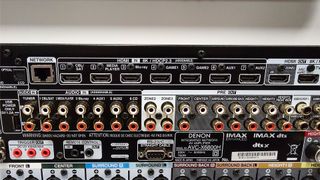Have you recently bought a Denon AVR or home cinema amplifier? Perhaps you've had one for years and are yet to unlock its full potential? Either way, you may not have considered these key tips and tricks which will help you achieve the very best home cinema sound experience – but don't fret, we're here to share some nuggets of wisdom to squeeze every drop from your Denon.
Whether you have any of the Award-winning models such as the AVR-X2800H, AVC-X3800H or the AVC-X6700H, or perhaps you've treated yourself to the latest and greatest AVC-X6800H model, these tips should be relevant to you.
Whether it's crucial setup procedures that will adapt the sound to best suit your room, or ensuring you've got the correct sound format selected, you'll want to check you have completed these steps to ensure you're getting the best home cinema sound possible.
1. Calibrate your AVR with the included microphone

Denon includes a microphone in the box with your AVR and, no, it's not for karaoke – sorry to disappoint. It's actually used to complete the integrated Audyssey calibration system which Denon includes across its range of X-series AV receivers and amplifiers.
Audyssey is a calibration software used for a plethora of audio devices from across hi-fi, home cinema, and even in-car audio systems. It works as so: the AVR will send a set of test tones to each channel, which the connected microphone will pick up and measure in reference to the shape of your room in order to best adjust the sound. It will then set the speaker levels and distances according to these measurements, however, we recommend double-checking these values and tweaking if necessary.
The setup process will ask you to set the microphone in three positions around your listening environment initially, however, we recommend that you continue the setup which includes moving the microphone to up to eight positions for more precise results.
2. Let your AVR breathe

A common mistake we see is people cramming their Denon (or any AVR for that matter) into cluttered entertainment units or, even worse, into cupboards and closing the door. While this may look neat, the truth is that your AVR will kick out quite a bit of heat in use, so ventilation is key to prevent overheating.
We'd recommend not putting your Denon in an enclosed cupboard space in order to avoid this happening. Plenty of ventilation is required so opt for an open shelf or (if your space facilities it) a hi-fi rack if possible. The good news is that Denon's range of AVRs is gifted in the looks department, even if the design has been around for quite some time, so feel free to show it off in the open air.
3. Set the correct sound mode

Denon includes support of a range of different movie sound modes across its AVR lineup, so it's important to ensure you have the correct one selected. While content should in theory default to the correct sound format, it's worth checking nonetheless as you might not be getting the full Dolby Atmos or DTS:X experience.
Press the button labelled "movie" on your Denon remote to bring up a menu of the available sound formats and ensure the system is in the correct sound mode for the content you're watching.
This extends to music too, as if you're streaming tracks via HEOS, Spotify Connect or Amazon Music, the chances are you won't want the full cinematic Dolby Atmos sound profile activated. Clicking the "music" button and selecting stereo is your best bet for the most authentic performance, however, the all-channel stereo is certainly worth a shot if you're in the mood for a dramatic, encompassing experience.
4. Check you're plugged into the correct HDMI sockets

Denon has a solid track record of including plenty of HDMI 2.1 sockets on its receivers, with the latest AVC-X6800H featuring no less than seven HDMI 2.1 inputs, while the AVC-X3800H has a total of six. This is excellent news for gamers, as plugging a PS5, Xbox Series X, Xbox Series S or even a PC with a supported graphics card will allow you to take advantage of the latest gaming features such as VRR, ALLM and 4K/120Hz gameplay. These sockets also support 8K up to 60Hz, which isn't a revolutionary feature right now, but it's appreciated future-proofing nonetheless.
However, some models aren't as well equipped. Take the AVR-X2800H as an example – it has a total of six HDMI inputs but only three are rated as HDMI 2.1 up to 40gbps. The three remaining ports are the HDMI 2.0 standard, which means you'll max out at 4K/60Hz and won't get access to all of the aforementioned gaming features.
The good news is that Denon marks which sockets are HDMI 2.1 with a little "8K" tag, although that might not be obvious to all users. On the AVR-X2800H it's HDMI sockets 4 (Game), 5 (AUX 1) and 6 (AUX 2) which are the full bandwidth sockets that gamers will want to plug their consoles into, so beware of that when connecting your gear to your Denon receiver.
5. Match your AVR with a complementary set of speakers

Denon amplifiers seem to share a consistent sound characteristic across the range, whether that's with the cheaper models like the aforementioned cheap AVR-X2800H model or the flagship AVC-X6800H. Each model we've tested delivers a smooth, rich and easygoing sound with plenty of warmth and oomph at the lower end.
Naturally, this means that they don't tend to offer quite the same level of agility and crispness as rivals from Sony and Arcam, but that isn't a knock to Denon as such. Personal preferences aside, you can pair your Denon with a surround sound speaker package that features a slightly leaner and more energetic presentation to create a better sense of balance. The Q Acoustics 5040 5.1 Home Cinema speaker package springs to mind here, as that set of speakers fits the above description perfectly.
Likewise, we'd recommend avoiding speakers that already deliver big, warm and rich sound, such as the Wharfedale Evo 4.4 HCP. Instead, they require an amplifier that offers a touch more energy and excitement into the mix, such as the Arcam AVR5 or Sony TA-AN1000.
MORE:
Read our full Denon AVC-X6800H review
And check out our picks for the best AV receivers

